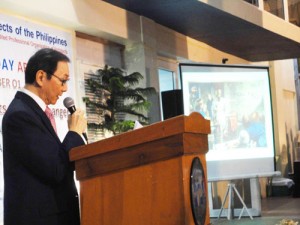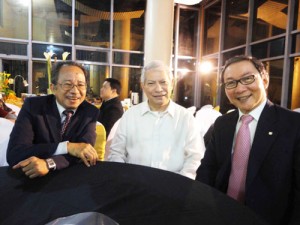Renowned Filipino architect Philip H. Recto calls on fellow architects: Be City Changers
Renowned Filipino architect Philip H. Recto calls on fellow architects: Be City Changers
By Armando D. Manaloto
MANILA–“Manila will be a dying city soon for lack of a good urban plan and the failure of its leadership to muster the political will to get organized around a strong urban planning authority to continually enforce the rules and implement them to make the city vibrant and relevant at all times,” according to Filipino architect Philip H. Recto, as he called on his fellow architects to heed the call to be ‘city changers.’
In a keynote speech before the United Architects of the Philippines (UAP) during the World Day of Architecture 2012 culmination night on October 1, Architect Recto said the city of Manila “still followed an old urban plan made almost 80 years ago and warned that it is bound to fall into urban decay as people will just keep moving farther away from the decaying city.”
The UAP is the integrated and accredited professional organization of Filipino architects in which Recto is a leading member of its College of Fellows. It is part of the global Union International des Architectes (UIA) which decreed every first Monday of October of each year as “World Day of Architecture,” the same day that the United Nations observes “World Habitat Day” to reflect on the state of human settlements and the basic right to adequate shelter for all.
The UIA, an international non-governmental organization that represents over a million architects in 124 countries, has nominated this year’s theme as “Architects are city changers.”
As global populations rise, with city dwellers expected to make up 70% of the world’s inhabitants by 2050, it will be the responsibility of architects to shape the urban fabric and develop the necessary tools to accommodate the citizens of the 21st century, it noted.
To achieve these goals, the UIA declared that it is essential to: mitigate climate change, reduce pollution, and improve management of resources and energy; structure cities so that they are socially inclusive, accessible and equitable, eliminating discrimination and precarious housing; develop cities that can resist crises and cataclysms, whether natural or man-made; develop economic, educational and creative opportunities for all; and, ensure the security and sanitary conditions essential to all individuals.
Arch. Recto cited the latest National Statistics Office (NSO) report that Metro Manila has the highest population density among the country’s regions, with 19,137 persons per square kilometer in 2012, which is about 62 times higher than the national average of 308 persons per square kilometer.
What is even more alarming, Recto noted, is that this represents about 20% increase from 16,032 persons per square kilometer in 2000, and almost 50% increase from 12,830 persons per square kilometer back in 1990.
In the context of such ‘handwritings on the wall’ as climate change, Recto expressed faith in Filipino architects to cope with the challenges through trends and initiatives that adhere to green architecture practices, specifically along the standards of “B.E.R.D.E.” which is more appropriate to Philippine tropical conditions.
He said that with rapid population growth, it is inevitable that future developments will go high-rise as more people can be accommodated on less land space, considering such other factors as adequate open space, availability of public utilities, infrastructure and public transportation.
Arch. Recto cited the example of Singapore where the city-state has been very successful in its public housing program by accommodating 90% of its citizens comfortably within the small confine of land. He said that in Singapore, they have strict urban development guidelines which allow high-rise construction to occupy only around one-third of the lot area, leaving the rest for open space, gardens and parks.
Arch. Recto gained invaluable experience in the design and supervision of modern high-rise office buildings, residential condominiums, schools, churches and industrial buildings during a 5-year stay in Singapore from 1971 to 1975. He was the architect-in-charge of the 50-storey International Plaza, the tallest building in Singapore at the time. In 1972, he became an associate member of the Singapore Institute of Architects and in 1984, he was admitted as a member of the ASEAN Association for Planning and Housing.
Arch. Recto was given the “1998 Outstanding Architect of the Year” award by the Professional Regulation Commission, the government agency mandated to license and regulate the practice of Filipino professionals, including 15,000 architects. The Award, one of the highest recognitions for a Filipino architect, was personally presented by His Excellency, President Fidel V. Ramos, during the Philippine Centennial Celebration.
A well-respected architect, Recto is the recipient of many other prestigious awards, among them is the “Araw ng Maynila” Mayor’s Award of Honor for Art and Culture bestowed by Mayor Jose Atienza, Jr. during the 428th founding anniversary of the City of Manila.


Comments (0)